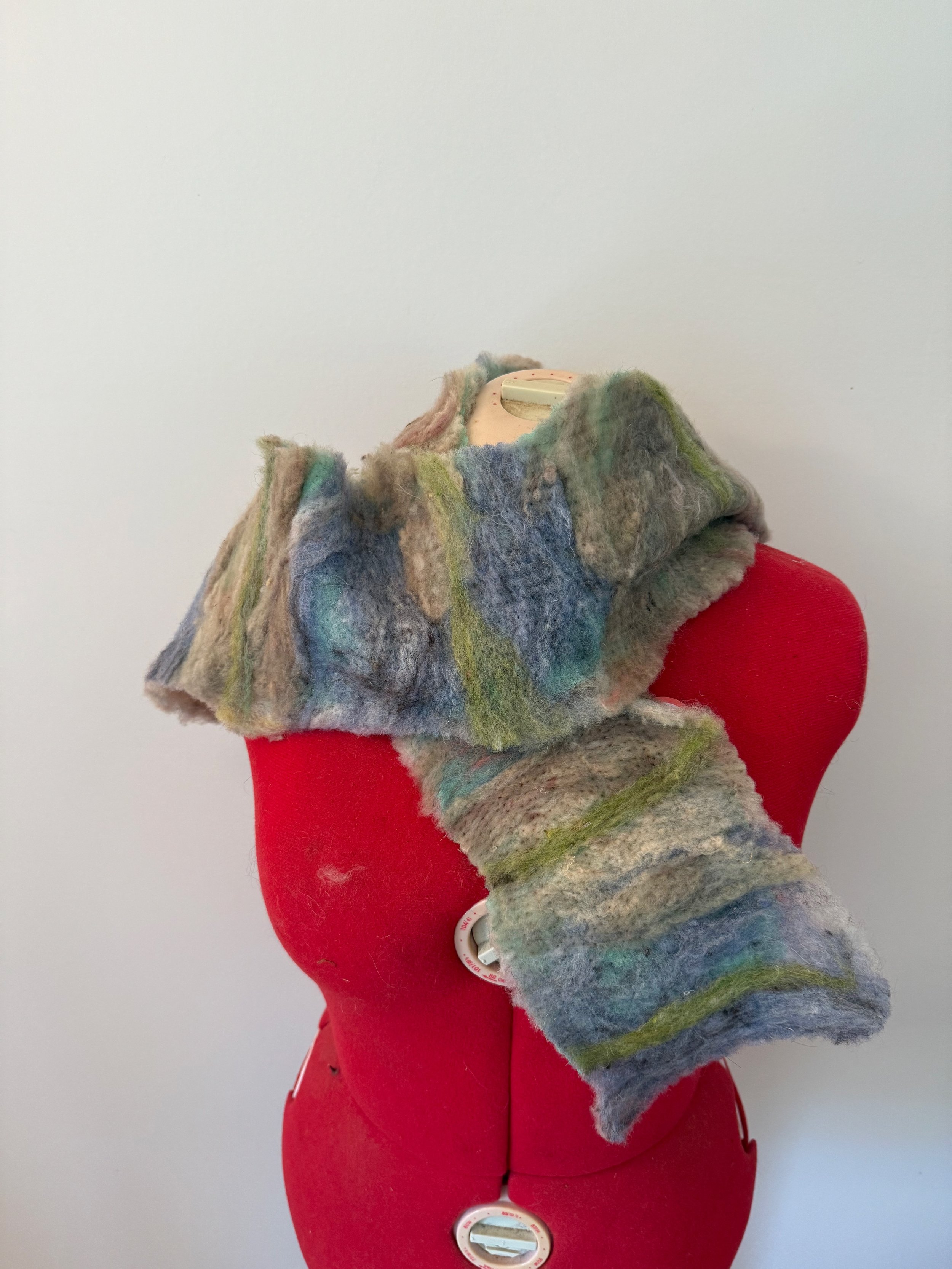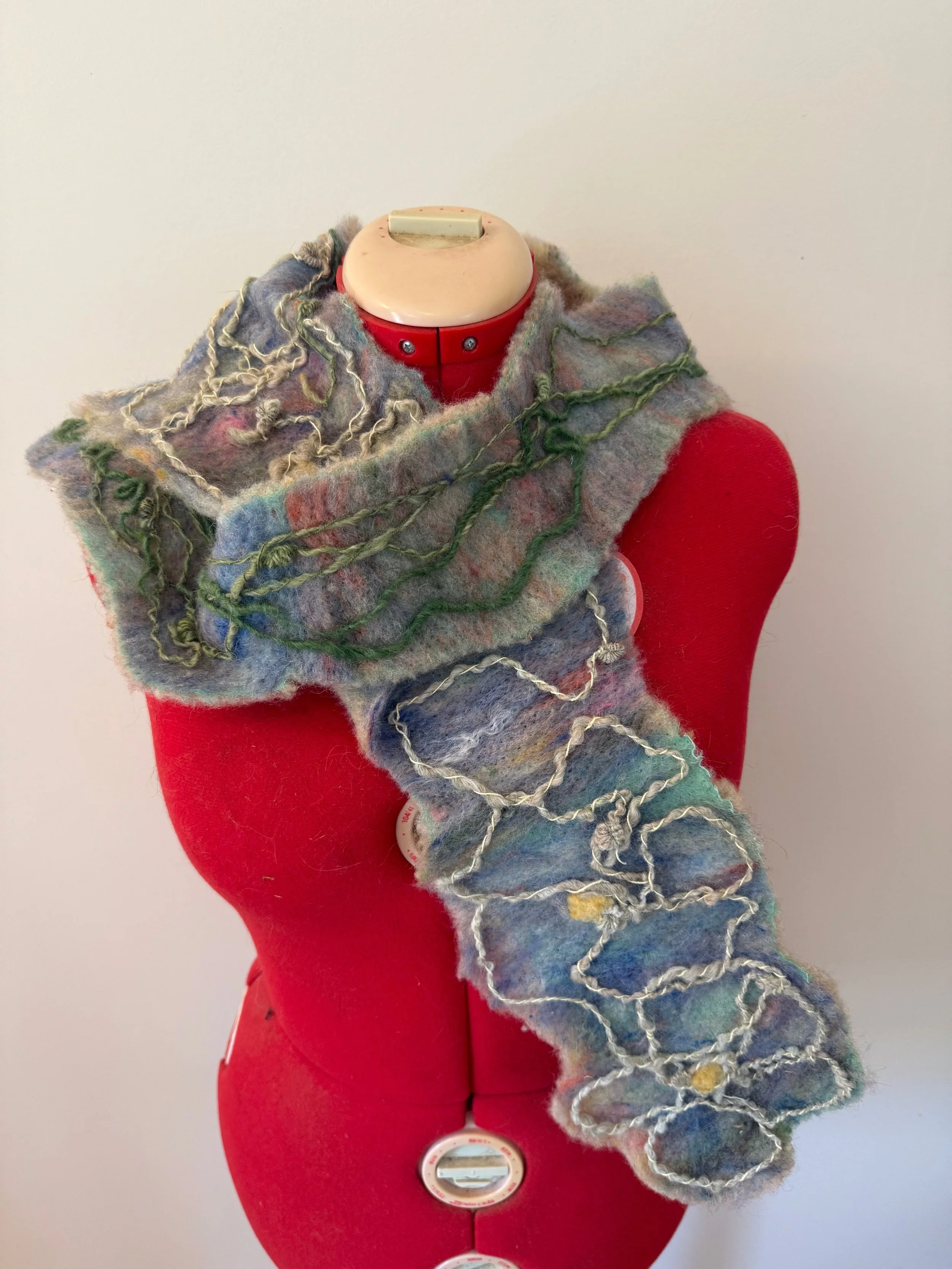Needle Felting with Chiffon
The topic I will be discussing in this blog is needle felting with chiffon. More particularly, is it possible to use a needle felt loom to create products that incorporate chiffon? We have used chiffon in wet felting (and nuno felting) with success. I wanted to determine if we could use the needle felt loom (hereafter simply called the felt loom) to work with chiffon, as the felt loom allows one to make certain products much faster (and easier) than wet felting.
For wet felting, we sandwiched the chiffon gauze between two thin layers of fiber, allowing the the chiffon to be slightly larger than the (wool and mohair) fiber. Doing this we have made great looking shawls where the colors of the chiffon can be seen through the fiber layers and the edges have a wispy edge (from the chiffon). Given we have used chiffon gauze in wet felting to good effect, the question was could we successfully use chiffon gauze in needle felting.
A quick recap of how the felt loom works. The felt loom is a marvelous tool that allows one to relatively quickly make flat needle felted products - e.g. shawls, scarfs, and cat mats. It incorporates a bank of needles and a roller to needle felt flat fiber. (The felt loom at Withers Wool has approximately 250 needles, in 6 rows, and is three feet wide.) To make a product on the felt loom, you take a batt (made on a drum carder), set down two layers of fiber from the batt, and then run it through the felt loom a number of times; each time strengthens the bond made by needle felting and also makes the fiber stiffer.
The bottom line is that it is possible to use chiffon with the felt loom - with a number of caveats and considerations; the rest of this newsletter will relate what we have learned. (The chiffon 8 mm gauze we used describes a lightweight, sheer chiffon silk fabric with a weight of 8 momme, characterized by its fine, gauze-like weave.)
First, we made a number of small samples. What we learned:
The wet felted shawl had the chiffon sticking out over the edges of the fiber mixture - and it looked good. However, when using the felt loom, if the chiffon sticks out from the sides of the batt, it looks poor - tattered and frayed. So our first lesson is (unless you like the tattered and frayed look) the chiffon should not be larger than the batt.
Also, similar to wet felting, the chiffon should be sandwiched between two fiber layers. This adds integrity to the felted product, and, similar to the point above, if the chiffon is only on one side of the fiber, the chiffon looks tattered and frayed.
A main reason for using the chiffon is to be able to see the color of the chiffon through the batt after it is felted. If you use a dark color for your batt, then essentially the side with the dark color is opaque and the chiffon cannot be seen. And since fibers mix with needle felting, if you have a dark color on one side and a light color on the other side, the dark fibers come through on the light side and are very visible. So best to use a light color. Additionally, the fiber layer on either side of the chiffon should not be too thick, or again, it will be hard to discern the chiffon gauze and whatever color you used.
The chiffon adds structural integrity to the felted product. Normally when using the felt loom, you must run the product through the felt loom a minimum of two times to create a viable product. However, the extra layer of the chiffon gauze with its small holes and the fact it already has structure means that you can actually run the product (batt on each side and chiffon gauze in the middle) thru the felt loom once and have a viable piece. (Safer to run thru twice but once does work.) And running thru the felt loom once means the felted outside is very soft.
We ended up applying these lessons to making a variety of scarfs and shawls. A few other observations:
You have to decide how to finish the product, i.e. the edges. You can leave them as is, trim with a rotary cutter, or trim with a scallop or pinking shears. What we found is there is a distinct difference to the look on the side depending on when you cut it. If you want to see a distinct layer of the chiffon, cut after finished with all the felting. If you want to have a slightly fuzzy look, cut one pass before the final felting pass. (Our favorite look was to use the scallop shears and cut/trim before the final felting pass.)
Using chiffon with the felt loom sandwiched between two layers, as compared to not using chiffon, can improve the drape of your product. (Fabric drape refers to how a fabric falls and folds under its own weight, essentially how fluid or stiff it appears.) Why is this? First, chiffon gauze has high drape - i.e. it is fluid and clingy, flowing easily and creating soft, small folds. Second, using chiffon in the felting process allows one to run the product fewer times through the felt loom, so the final product is not as stiff.
Designing your product when using chiffon requires more planning up front - regarding the colors of the chiffon and batt, any accouterments added (e.g. roving, yarn and/or mohair locks), and the finish desired.
Update — This is an added bullet a week after the rest of the blog. We also tried needle felting using 3 mm silk gauze and that worked well. It is lighter (than the 8 mm gauze) and using it offers better drape. It is also less expensive. So all good points. But it can more easily catch sometimes on the needles in the felt loom and so you have to be prepared to gently pull on the product coming out of the loom if that happens. Also, if not completely covered with at least a small amount of fiber, it can really look worn and tattered, which makes sense as the silk 3mm gauze is lighter than the 8mm chiffon silk gauze.
Following are a few of the products made. (Easier to see the effects of the chiffon if looking at the product in person - but hopefully this will give you an idea of what we achieved.)
Needle felted scarf with chiffon - one pass through the felt loom so very soft
Needle felted scarf with chiffon - two passes through the felt loom; also shows the use of yarn as a decorative feature


